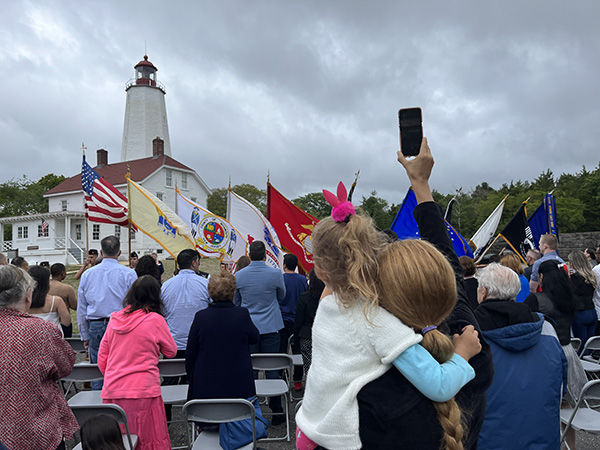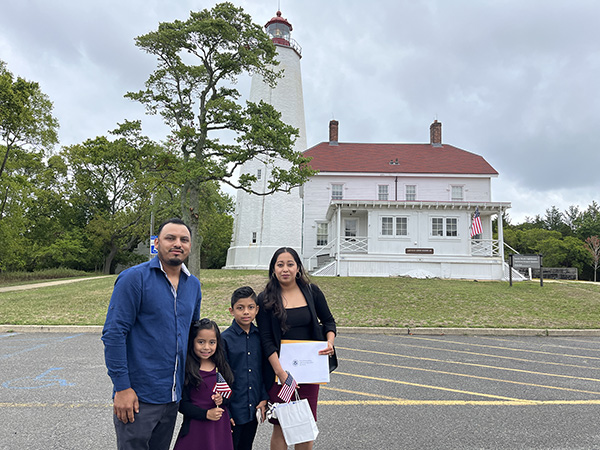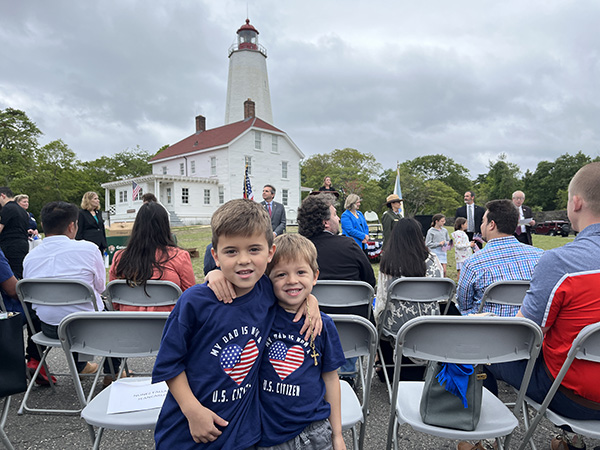
By Sunayana Prabhu
SANDY HOOK – There were no fireworks, but the euphoria of freedom was enough to brighten the cloudy day as 50 immigrants took their U.S. citizenship oath during a naturalization ceremony held Sept. 7 at the Sandy Hook Lighthouse.
The Monmouth County residents represented 29 countries – from Argentina to Uzbekistan – but became “citizens of the greatest country that civilization has ever seen” when they rose to take the Oath of Allegiance, said John Thompson, district director of U.S. Citizenship and Immigration Services (USCIS), who led the ceremony.
The naturalization ceremony was organized by officials from Gateway National Recreation Area and USCIS at the lighthouse, a National Historic Landmark, to celebrate the conclusion of an immigrant’s journey to citizenship and honor the commitment they’ve shown along the way.
The day also marked another milestone as Gateway National Recreation Area celebrated 50 years since its own creation by an act of Congress Oct. 27, 1972.
Thompson, along with Jennifer Nersesian, superintendent of Gateway National Recreation Area, state Assembly members Victoria Flynn (R-13) and Gerry Scharfenberger (R-13), and Highlands Mayor Carolyn Broullon, presented naturalization certificates to each of the new U.S. citizens, calling out their distinctive names, steeped in diverse cultural identities.
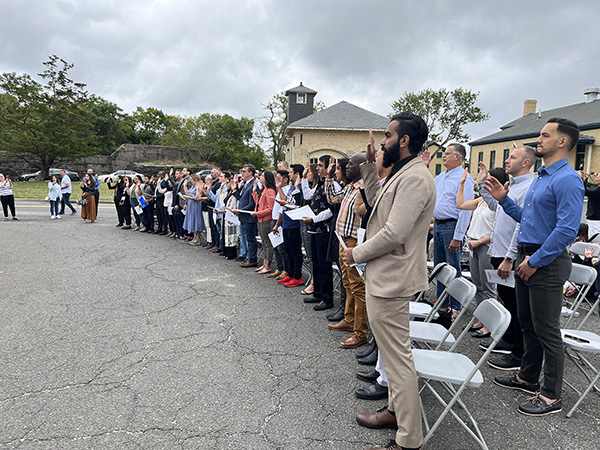
29 different countries pledged their allegiance to the United States of America in front of Sandy Hook Lighthouse. Photo by Sunayana Prabhu
The Ceremony
The gathering blended tears and smiles as the newest Americans held their certificates of citizenship close and their loved ones closer. Families and friends hugged, mothers clutched their babies in joy, while some stood alone, having made the journey to U.S. citizenship by themselves. Proud and free, together they stood up, raised their right hands and repeated two oaths that completed their naturalization and allegiance to the United States of America.
“The Oath of Allegiance to the United States has always been special because you’re not pledging allegiance to any person. You’re pledging allegiance to protect the constitution and laws of the United States,” said Thompson.
With the first oath, candidates renounced allegiance to their homelands, permanently departing from the 29 different countries as they pledged to “absolutely and entirely renounce and abjure all allegiance and fidelity to any foreign prince, potentate, state, or sovereignty, of whom or which I have heretofore been a subject or citizen.”
During the second oath – one every U.S. citizen learns as a child in school – they pledged allegiance to the United States of America, a country they were not born into but instead chose for life: “I pledge allegiance to the flag of the United States of America, and to the republic for which it stands one nation under God, indivisible, with liberty and justice for all.”
“All the work, the drive, the anxiety, the hope that has led you to this point takes determination and courage,” Nersesian said amidst thunderous applause. “I know how hard it is to leave your homeland behind, maybe members of your family or pieces of your own history.”
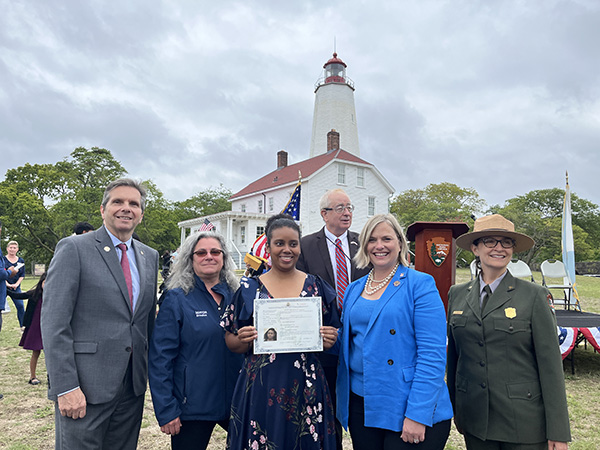
The Newest Citizens
Two children sported T-shirts with the words “My Dad Is a US Citizen,” announcing to the world that their father, Daniel DaSilva, originally from Brazil, is now an American. DaSilva had been in the immigration process since his children were born in 2015. “I feel like I’m part of their future now,” he said.
Many of the new citizens came to America to escape war, including Anastasia Gousha from Ukraine. Gousha said she applied for her citizenship this year in February because in her country, “people are dying. War is not worth it.” She said she went through the immigration process that took almost a year, but she is very grateful that she is alive.
“You know, I have freedom,” she said proudly.
Priya Yarm was born in South Africa, lived in Canada and moved to the United States to “be part of America. We wanted to be part of the foundation and live out the rest of our lives here in this great country,” Yarm said.
Some people chose to come to America just to be part of moving society forward. “I think at this stage, you’re a little bit more knowledgeable about what’s going on, and you want to have a little bit more impact in the community, be able to contribute in different ways,” said new citizen Andrew Paulson, who migrated to America as a teenager 25 years ago from the United Kingdom.
Griselda Merino, from Mexico, has been working in a nail salon and said she was “very happy” to take her oath. She giggled in excitement when asked what her next dream was: “I want to open my own place,” Merino said.
Drawing inspiration from the historic lighthouse, which will be etched in the personal history of 50 families forever, Nersesian reminded the gathering that “we are a nation of immigrants, whether recent or generations back. Our forefathers fought for the freedoms we enjoy today. How appropriate that today the Sandy Hook Lighthouse should serve as the site for welcoming people seeking refuge and opportunity in our country as new citizens.”
Each speaker at the ceremony acknowledged the immigrants’ struggle. Their journey reminds “people who were born here, like us, how unique this country is,” Scharfenberger said, “that people would leave their homelands and come here just to become Americans.”
“May each of you be a beacon of light to others around you, the prime example of what it means to be free,” said Broullon, who is a first-generation American. “I know my father had to go through this back in the ’50s,” she said. “And it’s just very heartwarming to see the look of hope on everyone’s face.”
The Path To Citizenship
Sept. 17 is Citizenship Day to recognize all who, by coming of age or by naturalization, have become U.S. citizens. The USCIS has been hosting naturalization ceremonies this month at landmark sites around the country, not only to make these events meaningful for those who have voluntarily chosen to participate in American democracy, but also to reflect the strength and spirit of the United States.
The average waiting period for the citizenship process is 11 months, according to USCIS, but depending on every individual’s journey and financial stability, it could be decades until they hold a legal citizenship certificate. In addition to the application process – which may run into thousands of dollars if one opts for assistance from a private attorney – the citizenship candidates have to pay and prepare for an English as a second language test and a civics test at a cost of roughly $800. The fees are nonrefundable, regardless of whether the U.S. government approves or rejects an application.
While the expense can be a deterrent for some, Thompson defended the agency’s fee structure, explaining that the funds pay for USCIS to process each application.
The USCIS has a Citizenship Resource Center that provides helpful resources and free study materials to prepare immigrants for the application process and citizenship tests and also with assimilating once they become citizens. For some that starts with learning English; for many others it is a lifelong pursuit to find a home in strangers.
Freedom and Risks
Concerns over undocumented immigrants are not ignored by the Justice Department and only serve to amplify the struggles of those who did commit to being legal citizens. “The oath that they take is extraordinary,” said Flynn, reflecting upon the founding fathers and the U.S. Constitution while noting the endurance of immigrants. “I think they should not diminish that fact that they took a step forward that is probably really difficult,” she said. “We appreciate it.” During his speech, Scharfenberger hinted at the recent spike in hate crimes throughout the country as bias incidents in New Jersey continue to rise at an alarming rate. “The country goes through rough patches here and there,” he said.
Earlier this year in April New Jersey acting Attorney General Matthew J. Platkin announced that 2021 was a record-high year for reported bias incidents in the state, with Monmouth County alone reporting 3.2 incidents per 10,000 residents, the third highest rate in the state.
But Scharfenberger told the new citizens that “this country protects free will, and that’s the most important thing to me.” He said true freedom is “the freedom to run for office, the freedom to vote for who I want to represent us. The freedom to speak out when I see something wrong or something I don’t like and the freedom to speak out and say, ‘This is the way I think it should be.’ And by ‘I,’ I mean Americans.”
Law enforcement agencies have bolstered their efforts to engage, educate and provide citizens with resources to report bias crimes. Both, state and federal justice departments encourage victims to report bias to their local police departments, or via the NJBIAS online portal at bias. njcivilrights.gov or by calling 800-277-BIAS.
Regardless of prevalent racial injustices, none of that fear stopped these 50 immigrants from celebrating their new American citizenship.
The article originally appeared in the September 15 – 21, 2022 print edition of The Two River Times.


